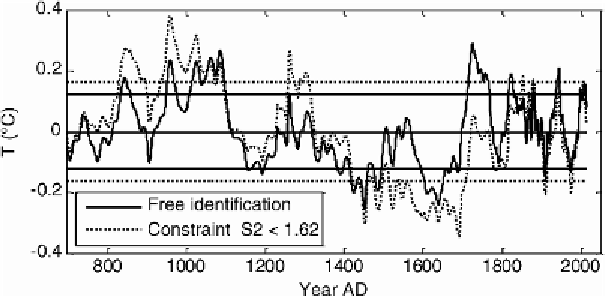Geoscience Reference
In-Depth Information
Due to the constraint on solar irradiance, the warming seen on the 20
th
Century is then attributed almost completely to CO
2
. Despite a doubling of
the coefficient on the sensitivity to volcanic activity, and a reduced
equilibrium temperature, the temperature simulated over the entire
millennium is far from matching the one that was produced by
free identification. Figure 7.6 compares the output errors with and without
the constraint on sensitivity to irradiance, and shows ranges at
±
1
standard
deviation.
The deterioration in output error (with 35% variance) is blatant. This is
largely due to the poor reproduction of preindustrial temperatures, caused by
a lack of sufficient contribution of solar activity. Through the optimization
method, the estimated rise in climate sensitivity
S
clim
(from 1.28 to 3.92
°
C)
nevertheless allows the error to return to zero more quickly after the
year 2000.
Figure 7.6.
Comparison of output errors
Moreover, the weak static sensitivity coefficient imposed on solar
irradiance does not allow us to obtain sufficient dynamic sensitivity, despite
the parameters remaining free in the model. The contribution of Schwabe
cycles on modern temperatures is significantly affected, as shown in
comparative Figure 7.7.



Search WWH ::

Custom Search